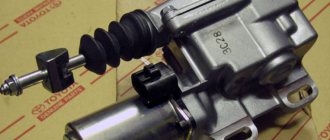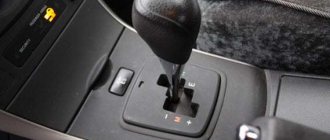The robot initialization procedure on a Toyota Corolla 2008 model year is carried out after transmission repairs associated with the installation of a new control unit or clutch. To set up, you can use a computer or make adjustments by performing a sequence of actions with the selector and brake pedal. If the adjustment is incorrect, the wear of structural elements accelerates or the gearbox stops switching gears.
The robot is initialized after the transmission has been repaired.
Gearbox robot
The unit is a standard manual transmission with a dry clutch, which is equipped with electromagnetic control drives. The actuator mounted on the crankcase receives signals from the control unit. The device opens and closes the clutch while simultaneously switching gears.
The robotic gearbox is cheaper than classic automatic transmissions and is inferior in smooth operation and reliability.
What is initialization
The procedure involves resetting the data stored in the memory of the control unit. The information returns to the factory settings; during programming, the controller records the drive strokes necessary to control the speed change drive.
After disassembling transmission units or installing a new gear selection mechanism, additional calibration is required.
Robot purpose
The design of the robotic box of the E-150 generation Toyota Corolla uses an electrical mechanism connected to a control unit. Power drives allow you to switch gears automatically, simplifying the process of driving in dense city traffic. The controller is equipped with a diagnostic system; if a malfunction is detected, an error code is entered into the memory, and a warning indicator in the form of a gear is turned on in the instrument cluster.
The box design uses an electrical mechanism.
Functionality
The robotic transmission allows you to change gears without human intervention, and the adaptable control unit takes into account your driving style. Support for manual selection of steps has been implemented (using the selector), and there is a reverse travel mode. In 2005, an early version of the Freetronic gearbox with an automatic centrifugal clutch was introduced. Due to low reliability, the unit was quickly discontinued; the 2007 model year Corolla began using the Multimode option with a power-driven clutch.
Principle of operation
The robotic gearbox can operate in two modes:
- In semi-automatic mode, in this mode, using the selector lever, which is located under the steering wheel, you can switch from low to high gear;
- In automatic mode, in this mode, all work occurs thanks to the algorithm of electronic units, which are based on the input signals of the sensors.
Therefore, in different sources the Robot may be called a sequential or sequential gearbox.
It is worth knowing that operating a car for a long time at temperatures below 30 degrees with such a transmission is not recommended.
How to distinguish between a gearbox and a robot
You can distinguish a classic automatic transmission from a robotic one by the following characteristics:
- by the absence of an actuator module under the hood connected to the clutch fork, and additional positions for manual switching M- and M+ on the selector pad;
- based on the results of computer diagnostics, which will indicate the modification of the transmission;
- by deciphering the vehicle’s equipment by VIN number;
- by the appearance of the selector, which provides additional modes and a Shift Lock button to release the transmission lock when the engine is off;
- according to the year of manufacture of the car, after restyling in 2010, the manufacturer refused to install the robot.
You can distinguish a manual transmission from a robotic one by the presence of an additional clutch pedal and a gear shift lever with a pictogram on the head. Manual and automatic transmissions were offered with a 1.6-liter 124-horsepower 1ZR-FE engine and a 1.8-liter unit. The manual transmission was the base for 1.4 liter engines (cars produced until the end of 2008) and 1.3 liter, and was also used on the initial versions of sedans with a power plant based on the 1ZR-FE model.
You can distinguish the gearbox by the appearance of the selector.
Opinions of owners of cars with a robot box
Are you wondering whether it’s worth buying a robotic Toyota Corolla, whose owners’ reviews almost scream: don’t even think about buying a car with a robotic gearbox? In this case, once again carefully study all available opinions on the Internet. You cannot help but be alarmed by such reviews from the owners.
Igor from Tomsk
I bought this car in the last month of 2007. The equipment was wonderful: a modern panel, heated seats, a start button, built-in fog lights, etc.
The engine pulled perfectly, the suspension worked out all the irregularities, and everything would have been fine, but after three months, every time after 30 days I had to visit a service station to reset the errors - otherwise it simply would not start.
Then miracles began to happen to her: at an intersection she had to turn her head, like a pilot, to let oncoming and passing cars pass - she could get up and stand in the middle of the street or move at a snail’s speed, even if the gas pedal was pressed to the floor. I could no longer endanger myself and my family and parted with the car, selling it for 440 thousand.
Guys! Do not buy cars of those years with a robot - this is the most dangerous and unpredictable box.
Vladislav from Vologda
I will briefly describe the advantages and disadvantages of the robotic box that was on my Corolla, which I sold on time. MMT – this designation was on the box – had one advantage: a car with such a transmission consumed gasoline like a manual transmission, and if you didn’t press the pedal to the floor, even less. I'll just list the disadvantages:
- On a steep climb I could spontaneously move back a little.
- When accelerating quickly, it shifts gears too slowly.
- When accelerating, the gears shift jerkily; if this happens during smooth acceleration, take the car to a service station.
- If you are stuck in a traffic jam going uphill, the clutch overheats (once I had to stand for 1.5 hours to cool it down).
- When ascending in icy conditions, do not let the automatic transmission change gears - immediately switch to manual mode.
That's all. Guys, don't buy cars with such a rotten robot.
Dmitry from Volgograd
I chose for a long time between mechanics and a robot, I went with the robot, the Internet said that it should go 100 thousand. The first acquaintance with the gearbox increased the adrenaline in the blood by 100% - it is impossible to guess what speed was turned on; at fifty on the speedometer, 5th gear is engaged. When switching, the car begins to twitch and takes a pause before turning on some speed.
I drove fifteen hundred kilometers in manual mode, gradually getting used to and understanding this robot. I realized that by turning on the speed to increase, you select the mode you need, in the opposite direction the machine resets itself quite adequately.
Then for a week I tried driving only in automatic mode in the city and on the highway.
I soon understood the principle of the robot’s operation: it’s all about the force with which you press the pedal. Give him time to think, and he will begin to make shifts smoothly without jerking.
If you want it faster, switch to sport mode, but the engine will only consume more fuel.
So to the question “Is it worth buying a Corolla with a robot?” I’ll answer: it’s worth taking, because the robot is not an automatic machine, it’s closer to a “mechanics” that thinks for the driver.
Boris from Rostov-on-Don
I have a 2007 Toyota Corolla with a 1.6-liter engine and a robotic transmission. So what's bad about the robot on the Corolla? I will answer: this is indeed a source of increased danger. I will describe what recently happened to me on the highway.
When overtaking, we barely caught up with the car being overtaken, a red signal lights up on my dashboard, the robot resets the gear and goes into neutral, although the selector is in the “M” position. I press on the gas to switch to “E” mode, but only the roar of the engine at high speeds, and the speed drops, a car flies towards me, and I somehow squeeze into the right lane, stop and light a cigarette with shaking hands.
I leaf through the instructions and find that I need to wait until the clutch cools down. But I understand how this attempt to overtake could have ended if the oncoming car had been closer. Here is the answer to the question, why is the robot on the King bad? Good luck on your journey.
Is initialization of the Toyota Corolla robot always necessary?
The procedure is carried out after repair work associated with partial or complete disassembly of the transmission, electric drives and control unit. Maintenance (such as oil changes or computer diagnostics) does not require a reset. Initialization can be carried out in case of incorrect operation of the transmission, but it is first recommended to check the condition of the manual transmission in a specialized service.
Benefits of use
Initialization allows you to adapt a new shift mechanism or clutch to the existing robotic transmission on the car. The machine owner or service personnel do not need to manually adjust the length or stroke of the rods. The controller receives information about the relative position of parts from sensors and calculates settings for fast and smooth speed switching.
Flaws
Frequent initialization is not recommended due to the risk of accelerated wear of the clutch disc and power drive. Automatic adjustment allows you to temporarily eliminate jerks or shocks that occur when you start moving and are a consequence of a faulty box.
It is not recommended to initialize the robot due to wear on the clutch disc.
The owner resets the settings, which allows the transmission to temporarily normalize, but does not eliminate the problem.
What causes the Corolla's manual transmission to go into neutral?
Operation of a robotic gearbox implies the presence of a malfunction such as engaging neutral gear. Often on a Corolla robot this happens as follows: the car is quite well warmed up, moves along the highway smoothly and without any obvious deviations, the check light suddenly lights up, neutral is switched on, and the car loses speed until it comes to a complete stop.
In order to fix the problem, you need to turn off the engine, wait a certain time and turn it on again. However, this move does not completely eliminate the problem.
If the manual transmission works in this way, then you should immediately contact the service station.
Often, failure occurs due to wear of a pair of release bearings, as well as the guide. If you replace these components, then diagnostics will not be required, and the replacement process can be carried out at home.
Setting up a Toyota Corolla 2007-2008 robot - step-by-step instructions
If the car owner does not have a diagnostic scanner, then the settings can be made by manipulating the brake pedal and the robot selector handle. To complete the work you will need a piece of copper wire or a steel clip. The procedure allows you to reset the controller (ECU) settings or initialize the clutch or transmission of the car.
Self-adaptation of the robot
Brief instructions on how to independently adapt the robot to a Toyota Corolla with an E150 body:
- Place the car on a level surface or in a garage box and place the transmission lever in the neutral position.
- With the ignition off, insert a wire or wire jumper into the diagnostic block, closing contacts CG and TC.
- Wait 10 seconds and then turn on the ignition circuits.
- Within 3 seconds, press the brake 7 times and wait for the double beep.
- Press the brake pedal and adapt the desired system using the gearbox selector. For example, to program the clutch, you need to move the lever from neutral through the positions E/M/+/M/-/M/+/M/-/E, and then return to the neutral position.
- After entering the setup mode, you should release the clutch and immediately press it again; if the manipulations are performed correctly, a triple signal will be given by the buzzer (the number of sounds depends on the selected initialization algorithm).
- After the end of signaling, you need to press the brake pedal 3 times within 2 seconds; if the procedure is performed correctly, the buzzer will beep 2 times (regardless of the selected initialization algorithm).
- Turn off the ignition and wait at least 10 seconds, and then remove the jumper from the diagnostic block.
- Start the engine and check the operation of the transmission; the inclusion of an emergency indicator in the form of a gear indicates the presence of malfunctions or incorrect adjustment.
Robot adaptation allows you to reset the car controller settings.
If during the setup process there are no sound signals or they sound at an increased interval, then the programming procedure should be interrupted.
To return to the initial stage, turn off the ignition circuit for 15-20 seconds. The number of initialization attempts is not limited and does not have a negative impact on the electromechanical clutch or gear shift actuators.
Setting up the transmission system
General initialization of the transmission is carried out according to a similar procedure, but it is required to move the selector according to the E/M/-/M/-/M/+/M/+/E scheme. If the algorithm is executed correctly, 4 buzzer signals are given (with an interval of 0.5 seconds). After completing the setup, you need to remove the paperclip and check the operation of the box while running.
Winter driving program
The robotic transmission does not support a special winter operating mode. Operating a car at negative air temperatures is no different from driving a car with a manual transmission. To warm up the crankcase and the electromechanical drive, let the engine idle for 3-5 minutes. At air temperatures below -25°C, there have been cases of spontaneous transition to neutral due to the solidification of the lubricant in the actuator cavity.
The Toyota robot does not support winter operation.
How to drive a Toyota with a robot
Recommendations for operating the transmission are listed in the manual supplied with the vehicle:
- avoid sudden accelerations that increase the load on the servos;
- when shocks occur, reduce engine speed;
- If the car gets stuck, you should not rock the car for a long time, alternately turning on the forward and reverse modes.
Possible problems with initialization
The clutch may not initialize the first time due to software errors in the controller or the use of a clutch from a manual transmission. The problem arose due to an error in the catalogs; spare parts suppliers offered the coupling as a budget replacement for the original unit. Due to the increased rigidity of the basket, the actuator cannot cope with the movement of the disk, which causes the learning process to end prematurely.
How to restore a problematic block
Some owners experience burnout of elements located inside the control unit. The problem can be solved by purchasing a new controller, but if you have the skills to install printed circuit boards and the appropriate equipment, you can try to restore the old one. One of the signs of failure of the control unit is error P0900, indicating a lack of power supply to the actuator (a gear icon appears in the instrument cluster).
At the initial stage, you need to try to remove the error. If the code is not erased, then you should check the presence of power at the corresponding contacts in the connector. If there is no signal, it is necessary to remove and disassemble the unit. Most often, the output transistors that supply power to the actuator control contacts fail. To solder elements, you need a hair dryer and a vacuum extractor to pump out solder. After installing new elements, you need to make sure there is no error and carry out the initialization procedure.
Corolla manual transmission goes into neutral
Spontaneous switching of the transmission to the neutral position, accompanied by the inclusion of a control indicator in the form of a gear in the instrument cluster, indicates a breakdown of the clutch drive. A scanner that is connected to the diagnostic connector will help determine the exact cause of the malfunction. When an incorrect operation of the mechanism is detected, an error with code P0810 is entered into the controller’s memory. The problem can be solved by rebuilding the old one or purchasing a new actuator, the service life of which is about 100 thousand km.
Share link:
Initialization of the robot gearbox in a Toyota Corolla car
Date: 12/13/2014
Problems and reasons for their occurrence
The most common models on which car owners encounter problems with the correct operation of such a transmission are Toyota Corollas released in 2007 and 2008; the reasons for the problems may be as follows:
- In winter, during long-term operation, the sensor that is responsible for changing gears freezes, as a result, when switching to the desired speed, it is knocked into the neutral position, so the car must be warmed up before operation;
- The actuator fails;
- In summer, the box may overheat;
- Clutch overheats.
The driver may also encounter the fact that while driving a well-warmed car, the Check engine lights up on the dashboard and the neutral gear is engaged, and the car stops; this may be due to the fact that the release bearings are wearing out and need to be replaced. You can replace them yourself at home.
What is a box robot?
At service stations, one of the frequently required services is the initialization of the robotic gearbox for some Toyota models, in particular for the Corolla.
Robotic transmissions are conventional manual transmissions with several additional features that make driving a car much easier. Shifting gears and clutches of the robot box occurs automatically: the gearbox reads the information transmitted by the driver, takes into account the driving conditions of the vehicle, after which the electronic control unit (ECU) processes this information and itself controls the operation of the box with a certain algorithm.
Modern robotic gearboxes are distinguished by the comfort characteristic of automatic transmissions, but at the same time, the fuel efficiency and reliability of operation remain the same as that of conventional mechanics. The robot also has a significant price advantage compared to classic automatic transmissions.
How to operate manual transmission correctly?
In order for the operation of an automated gearbox to be comfortable and reliable for as long as possible, it is necessary to follow a number of rules. Briefly about how to use manual transmission correctly:
- The robot does not tolerate sudden pressure on the gas pedal. The best option is when the driver chooses a calm driving mode. If you need to accelerate, it is also best to press smoothly. And, most importantly, remember a simple rule: PPTA - acceleration in manual mode, braking in automatic mode.
- One of the features of the robot is that during operation there are shocks when changing gears. In order to eliminate this factor, you can reduce the speed of the power unit.
- Thanks to the manual mode, you can easily get out of a snowdrift using the “swing” method. However, it is not at all recommended to skid on a robot, since the service life of the manual transmission is significantly reduced.
- During vehicle maintenance, it is necessary to initialize the manual transmission, as well as complete diagnostics. This is necessary in order to identify any problems at the stage of their occurrence.
Disadvantages of Toyota Corolla robotic gearboxes
Corollas with this type of gearbox were sold for several years (since 2006), but due to shortcomings, they were discontinued. Here are a number of their characteristic disadvantages:
- Frequent failures, due to which it is necessary to perform initialization frequently, sometimes every 5-7 thousand kilometers.
- Overheating of the clutch disc is often observed, which leads to its premature wear and the need for replacement after 60 thousand km.
- The control unit quickly fails, and it also has to be replaced with a new one.
- The gearbox takes a long time to respond, this is especially noticeable when driving in traffic jams.
Today, at most specialized warranty service stations for Toyota vehicles, the initialization procedure, replacement of the transmission control unit, and even replacement of the entire clutch kit along with the ECU are done free of charge under warranty. But sooner or later the warranty period ends, and the car owner has to solve this problem on his own.
What is robot box initialization, and in what cases should it be performed?
Initialization is a reset and zeroing of the previous settings of the electronic transmission control unit. This procedure is carried out every time there is a malfunction of the gearbox and after performing the following repair work in the transmission system:
- Replacement of the entire gearbox or its parts, which involved partial or complete disassembly of the gearbox;
- Replacement of the ECU, electric drive for gear selection and shifting, sensors for shifting mechanisms and gear selection;
In these cases, the ECU or transmission is initialized, the control system is configured, and calibrated.
- Replacement of the electric drive for engaging and disengaging the clutch, clutch travel sensor, clutch disc and its housing, release bearing, flywheel and crankshaft. In this case, after initialization and configuration, no additional calibration is required.
Important! Initialization must be carried out only for those nodes and elements of the robot box that have been replaced.
In what cases should initialization not be performed?
The ECU should not be initialized without a good reason. Frequent initialization is harmful to the clutch and leads to accelerated wear of its parts (especially the clutch disc). In addition, all the positive effects from it are short-lived. The most common misconceptions regarding the frequency of initialization:
- There is a misconception that the position of the clutch feed mechanism rack may indicate the need for this procedure.
- It also cannot be carried out in order to eliminate jerks and shocks at low speeds.
- The opinion that after initialization the car starts easier is also incorrect.
How to initialize?
It is better to entrust the initialization, configuration and calibration of the robot box to specialists. If you do not have this opportunity, follow the steps of the following instructions as accurately and carefully as possible.
- Put the car on the parking brake.
- Jumper pins 4 and 13 in the diagnostic connector, then wait 15 seconds.
- With the ignition on, quickly press the brake pedal 7 times (after which 2 beeps should sound).
- While pressing and holding the brake pedal, move the gear selector to the following positions depending on the initialization destination.
When initializing the ECU: NEV—M—MMEN.To initialize the clutch: NE- M- +- M— M- +- M- — -EN.
For transmission: NE- M- — -M- — -M- +- M- +- E- N.
- Release and then press the brake pedal again (3 series of 2 beeps should sound).
- Within 2 seconds, press the brake pedal 3 times. If the procedure is completed successfully, sound signals should sound: 2 - when initializing the control unit, 3 - clutch, 4 - transmission.
- Turn off the ignition and disconnect the inserted jumper from the diagnostic connector.
If the buzzer does not emit sound signals or the interval between them is more than 0.5 seconds, you should turn off the ignition, wait at least 15 seconds and start all over again (from step 1).
Device
Depending on the Toyota model, the robotic gearbox may have a different design, but the same principle of operation, which is based on the operation of a manual gearbox and a friction-type clutch. A special feature of this device is its double clutch, which continuously transmits torque while eliminating power interruption. The robotic gearbox of a budget model includes a servomechanism with a mechanical transmission electric motor, in which the speed of the controlled mechanism is approximately 0.3-0.5 seconds, but on sports models a box is installed in which the speed of the hydraulic switching mechanism is much higher.
Setting up the transmission system
After initialization, you should configure the robot control system. To do this, follow these steps:
- stop the car;
- move the gear shift knob to position N;
- turn off the ignition, then turn it on for 40 seconds;
- turn off the ignition again for 15 seconds;
- Turn on the ignition, start the engine and depress the brake pedal.
If everything is successful, the N lever position indicator will start flashing. After 10 seconds it should light up steadily, indicating that the setup is complete.
Important! The specified initialization and configuration methods are used in the absence of a portable calibration device. Setting up the robot box of a Toyota Corolla car using the device has a number of significant differences.
The transmission does not start
The most common malfunction when operating a 2007, 2008 Toyota Corolla is that the manual transmission does not engage gears. The reasons for such a breakdown may be the following factors:
- Long-term use of the car in winter. The sensor responsible for gear shifting “freezes”, because of this, when you try to change gear, the box is knocked into neutral.
- Gear shifting problems also occur due to a faulty actuator. If this mechanism breaks down, it must be replaced immediately.
- A similar problem can occur when operating a car in the summer. However, in this case, the robot on the Toyota Corolla 2008 simply overheats.
- The problem may occur if the clutch overheats.











